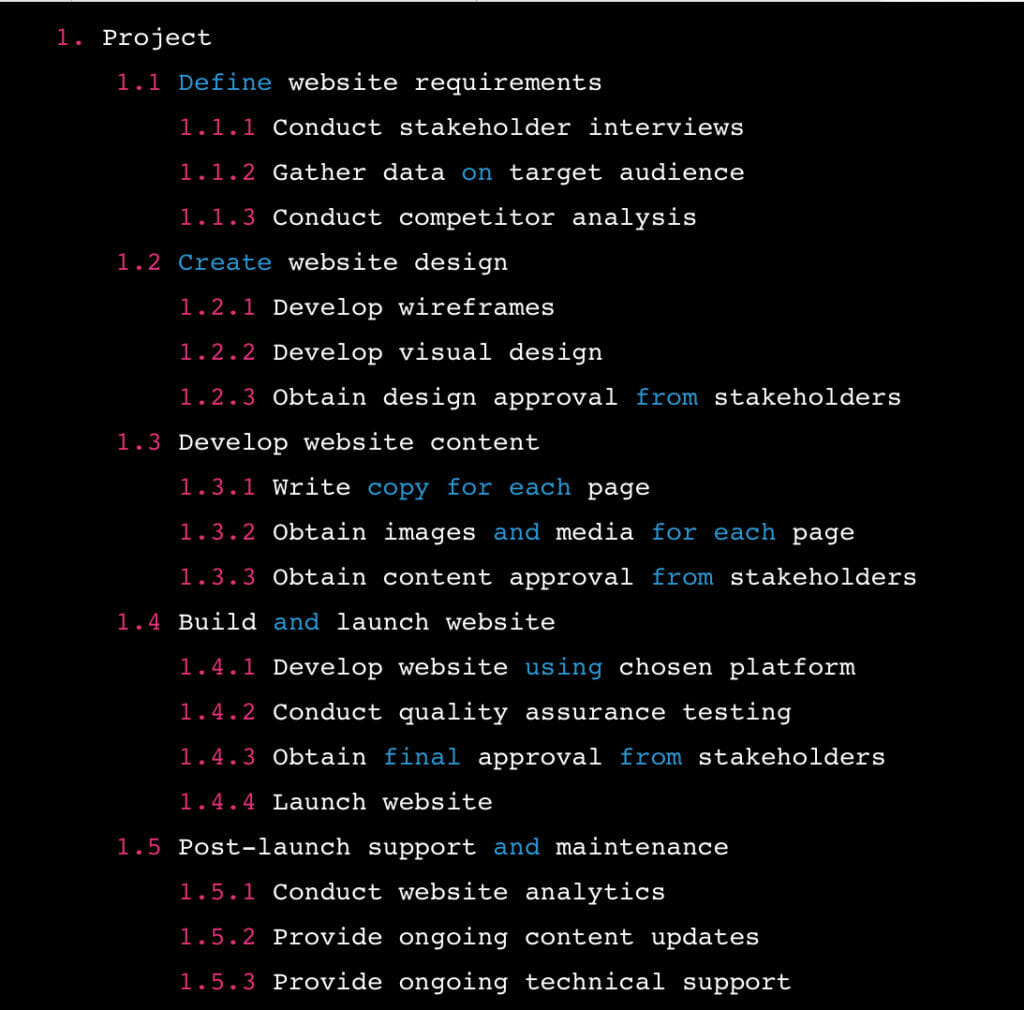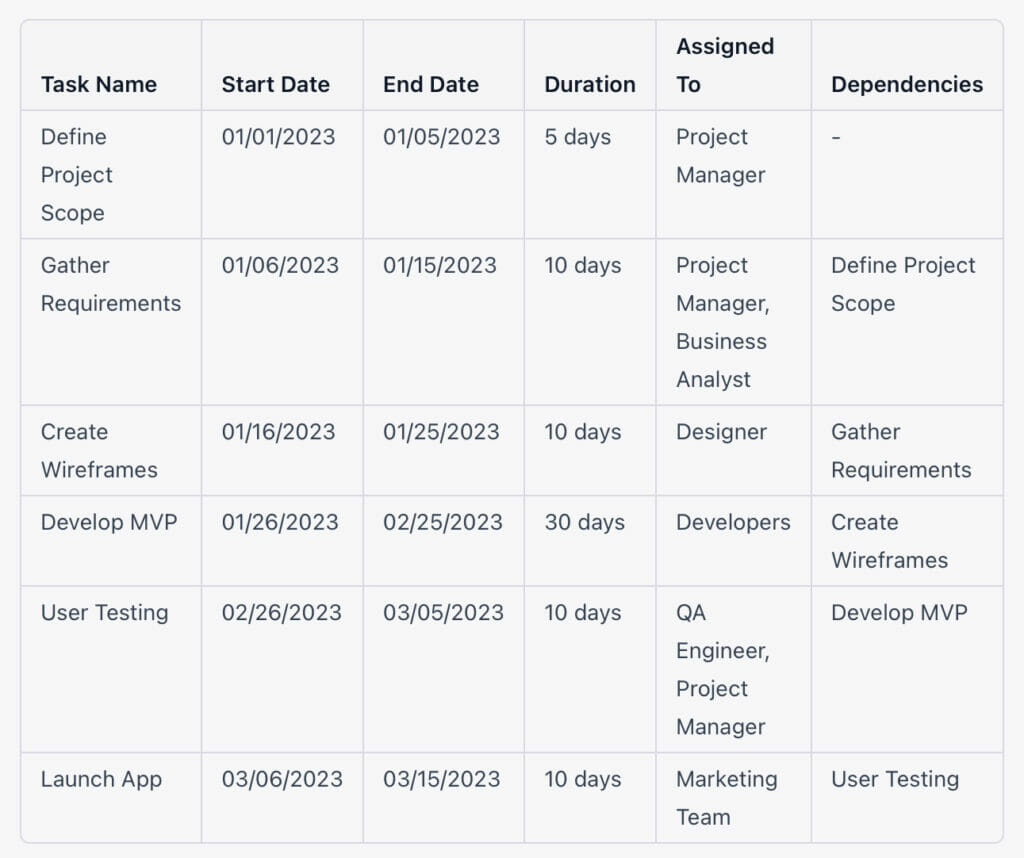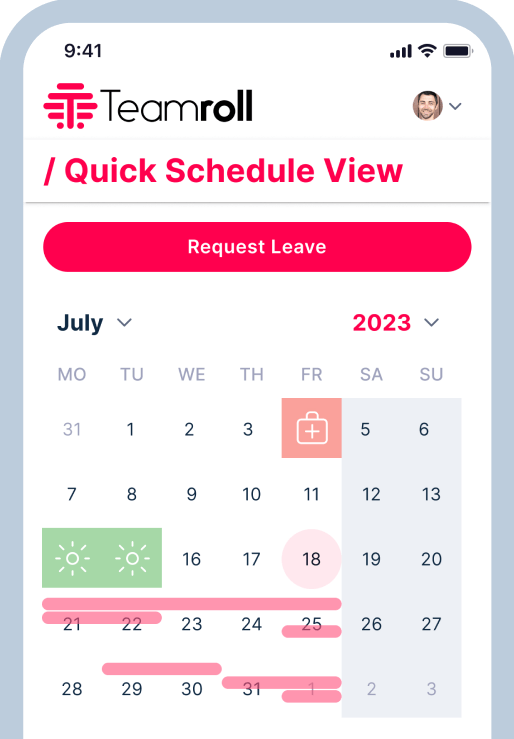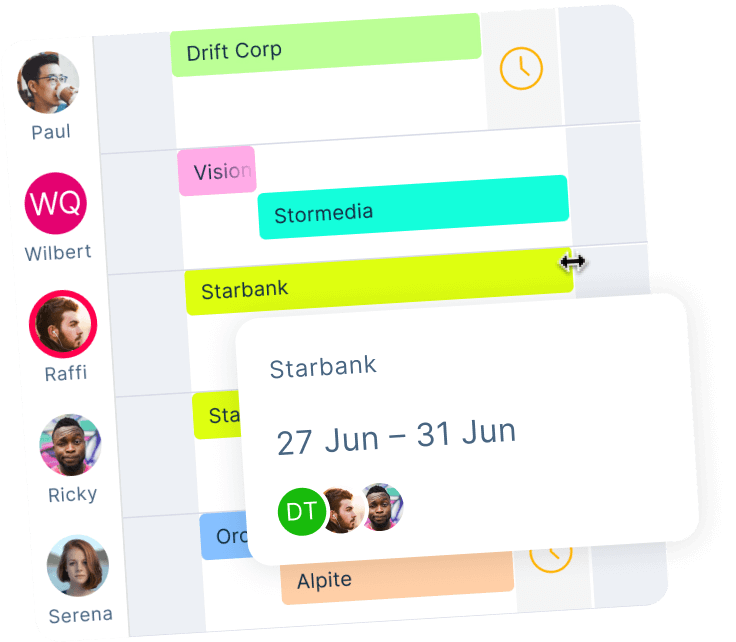10 Best Strategies for Managing Team Projects in 2023 (with examples!)
Are you struggling to manage your team and multiple projects effectively? Do you find it challenging to keep track of tasks, deadlines, and resources? You’re not alone. Managing team projects can be tough if you don’t have the proper strategies in place.

Managing team projects is a complex and challenging task that requires a solid project management process.
Without a proper plan in place, projects can easily go off track, leading to missed deadlines, wasted resources, and unhappy clients or stakeholders.
Having a robust project management process not only ensures that projects are completed successfully, but it also helps you stay organized, focused, and on top of your game.
With a well-defined project management process, you can set clear objectives, establish timelines, allocate resources effectively, track progress, and communicate with your team and stakeholders in a timely and transparent manner.
The result? A more streamlined and efficient project management process that can lead to happier clients, successful projects, and a more productive team.
1: Establishing Project Objectives and a Work Breakdown Structure
One of the most crucial steps in successful project management is establishing clear project objectives.
Without a clear understanding of what needs to be achieved, it can be difficult for teams to work towards a common goal.
To ensure that everyone is on the same page, it’s important to define project objectives at the outset and establish a plan for achieving them.
What is a Work Breakdown Structure?
A work breakdown structure (WBS) is a hierarchical decomposition of a project into smaller, manageable components.
The purpose of a WBS is to help break down a complex project into smaller, more manageable tasks that can be assigned, scheduled, and tracked.
By breaking down a project into smaller tasks, team members can focus on completing individual tasks and have a clear understanding of how their work contributes to the overall project.
A well-designed WBS provides a clear and comprehensive picture of the project’s scope and can help identify potential risks and bottlenecks.
The WBS is also useful for project estimation, as it allows the team to estimate the time, cost, and resources required for each task.
To achieve this, project managers should begin by identifying the key deliverables that need to be completed as part of the project. Once these deliverables have been defined, they can be broken down into smaller, more manageable tasks using a work breakdown structure (WBS).
Here is an example of what WBS for building a company website may look like:

Section 2: Creating an Effective Project Plan
When it comes to managing team projects, having a project plan in place is crucial. A project plan is a roadmap that outlines the project’s objectives, timelines, and deliverables.
This document helps teams stay on track and ensures that everyone is working towards the same goal. For small teams and businesses, having a project plan can be especially beneficial as it helps keep everyone focused and aligned.
How to Create an Effective Project Plan
To create an effective project plan, there are several best practices to consider. First, it’s important to determine the project’s milestones. These are significant events or deliverables that mark progress towards the project’s completion.
By identifying milestones, teams can track their progress and ensure that they are on track to meet their deadlines.
Another important aspect of creating a project plan is establishing due dates. Setting due dates for tasks and milestones helps teams prioritize their work and ensures that everyone is aware of what needs to be done and by when.
It’s important to be realistic when setting due dates and to build in some flexibility to account for unexpected delays or roadblocks.
Here is an example project plan for developing a mobile application:

Supercharge your remote or distributed team culture in 5 minutes or less
Get exclusive content we only share with our email subscribers.
100% private and secure. Unsubscribe anytime.

3: Resource and Team Management Strategies
For complex projects, managing resources is a critical aspect of successful project management. It involves balancing the available resources with project requirements to ensure efficient resource allocation.
10 practical ways you can improve your resource management:
- Clarify roles and responsibilities
- Set realistic goals for each team member
- Prioritize tasks
- Allocate tasks based on skill and passion
- Communicate effectively
- Provide regular feedback
- Celebrate successes
- Hold regular meetings
- Foster collaboration
- Provide training and development opportunities
In addition to resource management, team management plays a crucial role in project success. Managing project team members and building team cohesion is essential for ensuring everyone is working towards a common goal.
Communication is often at the top of the most effective ways to improve your team management and increase your productivity.
10 Tips to Communicate More Effectively:
- Active listening: Listen to what the other person is saying without interrupting them. Paraphrase what they said to confirm your understanding
- Clarify expectations: Make sure everyone is on the same page regarding what is expected of them in terms of their roles and responsibilities
- Be clear and concise: Avoid ambiguity by using clear and simple language. Get to the point and avoid lengthy explanations
- Choose the right medium: Use the right communication method for the situation. For example, face-to-face meetings might be better for complex discussions, while email might be more appropriate for quick updates
- Use positive language: Avoid using negative language or making accusations. Use positive language and focus on finding solutions rather than blaming others
- Respect others’ opinions: Acknowledge and respect the opinions and perspectives of others, even if they differ from your own
- Ask questions: Clarify points by asking questions. Avoid making assumptions and ask for more information when needed
- Give feedback: Give constructive feedback to your colleagues on their work, but be tactful and respectful when doing so
- Be open-minded: Be open to new ideas and perspectives, and willing to change your mind based on new information
- Follow up: Follow up on your conversations and ensure that everyone is on track to meet their goals and deadlines
4: Agile Project Management Strategies
Agile team management is an approach to project management that emphasizes flexibility, adaptability, and continuous improvement.
The Agile methodology is often used in software development projects, but can be applied to any project. The Agile approach values collaboration, iteration, and customer satisfaction over following a rigid plan.
When it comes to managing larger projects, an agile project management approach can provide several benefits, including:
- Increased flexibility: Agile project management allows for changes and adjustments to be made throughout the project lifecycle, which can be especially useful in situations where requirements may evolve over time
- Better collaboration: By breaking down projects into smaller, more manageable pieces, agile project management can improve communication and collaboration among team members
- Faster time to market: By focusing on delivering working software or products in shorter cycles, agile project management can help businesses bring their offerings to market more quickly
However, one potential pitfall of agile project management is scope creep. This occurs when the project scope expands beyond its original boundaries, leading to delays, increased costs, and potentially even project failure. To manage scope creep effectively, consider:
- Establishing clear project objectives and scope upfront
- Holding regular check-ins with stakeholders to ensure everyone is aligned on project goals
- Prioritizing features and requirements to focus on the most critical needs first
To implement agile project management techniques effectively, consider the following tips:
- Encouraging collaboration and communication among team members
- Focusing on delivering value to customers through frequent releases or iterations
- Prioritizing the most important tasks or features and focusing efforts there
- Holding regular meetings or stand-ups to ensure everyone is on the same page and any issues are quickly addressed
- Using tools like kanban boards or Gantt charts to help visualize the project and keep everyone informed of progress.
5: Using Project Management Tools and Platforms
As technology continues to advance, project management tools and platforms have become essential for managing complex projects.
These tools can help streamline processes, boost productivity, and ensure that projects are completed on time and within budget.
Overview of Project Management Apps and Platforms
There are numerous project management apps and platforms available, ranging from free to premium versions.
Some of the most popular ones include Trello, Asana, Monday.com, Jira, Basecamp, Microsoft Project, and our very own Teamroll.
These tools are designed to help teams collaborate, manage tasks and deadlines, and track progress.
Benefits of Using Different Project Management Tools
Different types of projects require different types of tools. For instance, agile projects might require tools like Jira, which offer features like burndown charts and sprint planning.
On the other hand, traditional projects might benefit from tools like Microsoft Project, which offer Gantt charts and resource management features.
Ease of Use and Customer Service Features
When considering project management tools and platforms, it’s important to keep in mind both functionality and user experience.
Look for tools that offer an intuitive interface and user-friendly design, making it easy for your team to get started quickly.
You should also consider the level of customer service and support available, such as video tutorials, knowledge bases, and community forums. These resources can help your team troubleshoot issues and get the most out of the tool.
Keep in mind that many software services have multiple package levels, and you can usually upgrade or downgrade your plan to meet your unique needs.
6: Establishing Clear Communication Channels
Effective communication is a key element of successful project management. Without clear communication channels, team members may not fully understand their roles and responsibilities or may struggle to share important information with each other.
Fortunately, there are a variety of tools and strategies that can help teams establish and maintain clear communication throughout a project’s lifecycle.
One popular tool for facilitating communication among team members is Slack, a messaging platform that allows users to send messages, share files, and collaborate in real-time.
Teams can create specific channels within Slack for different projects or topics, making it easy to stay organized and ensure that relevant information is shared with the right people. Slack’s mobile app allows team members to stay connected even when they are on the go.
Another popular tool for improving communication among teams is Microsoft Teams. This platform offers similar features to Slack, including the ability to chat, share files, and collaborate in real-time.
Teams also includes video conferencing and screen sharing capabilities, making it an ideal choice for remote teams or teams that need to work across multiple locations.
Tips to establish effective communication channels for your project team:
- Choose a communication tool that meets your team’s needs and preferences. This could be Slack, Microsoft Teams, or another platform
- Establish guidelines for when and how team members should use the communication tool. For example, you may require team members to check the tool at least once a day or to respond to messages within a certain timeframe
- Create specific channels within the communication tool for different projects or topics. This will help ensure that relevant information is shared with the right people
- Encourage team members to ask questions and seek clarification when needed. This will help ensure that everyone understands their roles and responsibilities and that the project is progressing as planned
7: Monitoring Project Progress and Performance
Monitoring project progress and performance is critical to ensuring that a project stays on track and meets its goals. There are several methods that team leaders can use to track their team’s project progress and performance, including:
Performance Appraisals
Performance appraisals are a useful tool for evaluating the performance of both individual team members and the project as a whole. It involves setting specific goals and milestones for team members to achieve and regularly assessing their progress towards these goals.
The process of performance appraisals can vary depending on the organization’s needs, but typically involves the following steps:
- Establish clear performance metrics: Clearly define what success looks like for the project and identify key performance indicators (KPIs) that will be used to track progress
- Set achievable goals: Set SMART (specific, measurable, achievable, relevant, and time-bound) goals for each team member that align with the overall project objectives
- Regularly assess progress: Schedule regular check-ins to assess each team member’s progress towards their goals and address any roadblocks or challenges they may be facing
- Provide feedback: Provide constructive feedback to team members based on their performance and progress towards their goals. This can help motivate team members and identify areas for improvement
- Adjust goals and metrics as needed: If the project scope or objectives change, be flexible and adjust goals and metrics accordingly to ensure that the team is still working towards achieving the desired outcome
Performance appraisals can be done manually using spreadsheets or other tracking tools, or through project management software that includes performance tracking features.
Key Performance Indicators (KPIs)
Key performance indicators (KPIs) are measurable values that indicate how effectively a team is achieving its objectives.
KPIs are used to monitor project progress, identify areas for improvement, and ensure that the project is meeting its goals.
Examples of KPIs that can be used in project management include:
- On-time delivery: This measures how often the project is completed within its planned time frame. If the project is consistently running behind schedule, it may be an indication that the team needs to adjust its processes or allocate more resources to the project
- Budget adherence: This measures whether the project is staying within its allocated budget. If the project is consistently going over budget, it may be an indication that the team needs to re-evaluate its resource allocation or find ways to reduce costs
- Quality of deliverables: This measures the quality of the work produced by the team. If the quality of the deliverables is consistently poor, it may be an indication that the team needs to improve its processes or allocate more time to quality assurance
By tracking KPIs, team leaders can identify areas of improvement and take action to ensure that the project stays on track.
Project Completion Assessments
Project completion assessments are a critical component of project management as they provide insights into the overall success of the project and identify areas for improvement.
This assessment can be conducted through a formal review process with key stakeholders or through an informal team debriefing session.
Some key areas to assess during a project completion assessment include:
- Meeting project goals: Assess whether the project met its goals and objectives as outlined in the project plan
- Budget adherence: Evaluate whether the project was completed within the allocated budget
- Timeliness: Determine whether the project was completed on time or within the scheduled timeline
- Quality of deliverables: Evaluate the quality of the project deliverables to ensure they meet the required standards
- Communication effectiveness: Assess the effectiveness of communication channels and strategies during the project, including identifying areas of improvement
- Team performance: Evaluate the performance of the project team, including individual contributions, team cohesion, and overall effectiveness
- Lessons learned: Identify lessons learned from the project that can be applied to future projects
By conducting a thorough project completion assessment, project managers can identify areas of improvement for future projects and help ensure the success of future endeavors.
8: Utilizing Subject Matter Experts
In project management, subject matter experts (SMEs) are individuals with specialized knowledge or expertise in a particular field or subject. Their involvement can be invaluable in ensuring that a project is successful.
The Importance of Subject Matter Experts:
SMEs can bring a wealth of knowledge and expertise to a project, helping to ensure that it is completed successfully. They can offer insights and recommendations that are specific to their area of expertise, providing valuable guidance to the project team.
SMEs can also help to identify potential risks and challenges and provide solutions to address them.
Identifying Subject Matter Experts:
Identifying SMEs can be a challenging task, but there are several strategies that can be used to help find the right individuals for the project.
One strategy is to seek out individuals within the organization who have expertise in the relevant field.
Another strategy is to conduct a search for external SMEs, either through professional networks or by hiring a consultant.
Utilizing Subject Matter Experts:
Once SMEs have been identified, it is important to utilize their expertise effectively. Here are some tips for doing so:
- Involve SMEs early on in the project: This will allow them to provide input and guidance throughout the project, increasing the likelihood of success
- Clearly define the SME’s role: Make sure the SME understands their role and responsibilities within the project, and ensure that they have the necessary resources and support to fulfill their duties
- Provide adequate training: If the SME is not familiar with the project management process or the tools being used, provide training and support to help them become more comfortable with their role
- Communicate regularly: Keep the SME informed of project progress and any changes that may impact their role or responsibilities
- Recognize and reward contributions: Show appreciation for the SME’s contributions to the project and recognize their role in its success
9: Implementing Team Building Activities
Team building activities are an essential aspect of building team cohesion and improving collaboration in the workplace.
They provide an opportunity for team members to get to know each other on a personal level, develop trust, and enhance communication so that you can better organize your team.
Here are some tips and examples of team building activities that can be implemented in different work environments:
Importance of Team Building Activities
Team building activities are essential for improving the productivity and efficiency of a team. They help in creating a positive and supportive work culture and improving employee morale.
By participating in team building activities, team members develop a sense of belongingness and shared responsibility towards achieving the team’s goals.
Team building activities can also help in enhancing communication, reducing conflicts, and increasing collaboration.
Tips for Implementing Team Building Activities
- Understand the team’s dynamics: Before selecting team building activities, it is essential to understand the team’s dynamics, including their strengths, weaknesses, and communication styles. This understanding will help in choosing the right activities that align with the team’s goals and objectives
- Make it inclusive: Team building activities should be inclusive, and every team member should be given an opportunity to participate. Activities that are biased or exclude certain team members may have an adverse effect on the team’s cohesion
- Keep it fun: Team building activities should be fun and engaging. Activities that are too complex or boring may lead to disengagement from team members
- Follow up: Follow up after the team building activity is essential to reinforce its impact on the team. It is crucial to create an action plan and ensure that the team members implement it
Team Building Activity Ideas
- Scavenger hunt: This is a popular team building activity that requires team members to work together to find hidden items. It promotes collaboration and communication
- Trust-building exercises: These activities are designed to build trust and encourage team members to rely on each other. For example, blindfolded obstacle courses or trust falls
- Escape rooms: Escape rooms are a fun way to build team cohesion. Team members have to work together to solve puzzles and escape a room
- Volunteering: Volunteering as a team can help build a sense of community and teamwork. Team members can volunteer at a local charity or participate in a community service project
- Team dinners: Team dinners are a simple but effective way to build team cohesion. They provide an opportunity for team members to socialize outside the workplace and build stronger relationships
10: Using Effective Leadership Styles
Effective leadership is critical in project management as it sets the tone for the team’s performance and success. Leaders who understand their team’s strengths and weaknesses and can adapt their leadership styles accordingly are more likely to achieve project goals.
Here are five popular leadership styles that you may find yourself among:
Autocratic Leadership
Autocratic leaders make decisions independently without seeking input from team members. This leadership style is best suited for projects where quick decision-making is required, and there is little room for discussion or debate. Autocratic leaders may be useful in crisis situations where immediate action is needed.
Democratic Leadership
Democratic leaders involve team members in decision-making, allowing for input and discussion. This leadership style can improve team morale and foster a sense of ownership and accountability. Democratic leaders may be more effective in projects where collaboration and creativity are required.
Laissez-Faire Leadership
Laissez-Faire leaders delegate decision-making authority to team members and provide little direction. This leadership style is best suited for experienced teams who require little supervision. Laissez-Faire leaders may be useful in projects where team members have specialized skills and knowledge.
Transformational Leadership
Transformational leaders inspire and motivate their team members to achieve their full potential. This leadership style is effective in projects where creativity, innovation, and collaboration are required. Transformational leaders may be more effective in long-term projects where team members require a sense of purpose and direction.
Servant Leadership
Servant leaders prioritize the needs of their team members and prioritize their growth and development. This leadership style is effective in projects where team members require support and guidance. Servant leaders may be more effective in projects where team members require mentoring and coaching.
Effective leadership is critical in project management. Different leadership styles can be used to manage teams effectively, depending on the project’s nature, the team’s skillset, and the desired outcome. Understanding and utilizing different leadership styles can improve team morale, foster a sense of ownership and accountability, and ultimately lead to project success.
Final Thoughts on Managing Team Projects
As you embark on your project management journey, it’s important to remember that there is no one-size-fits-all approach. Each project is unique, as are the team members involved.
It may take some trial and error to find the project management tools and strategies that work best for your team and project needs.
So don’t be afraid to try new things, take risks, and learn from both successes and failures. With the right tools and techniques, and a willingness to adapt and evolve, you can achieve great things as a project manager and as a team.


